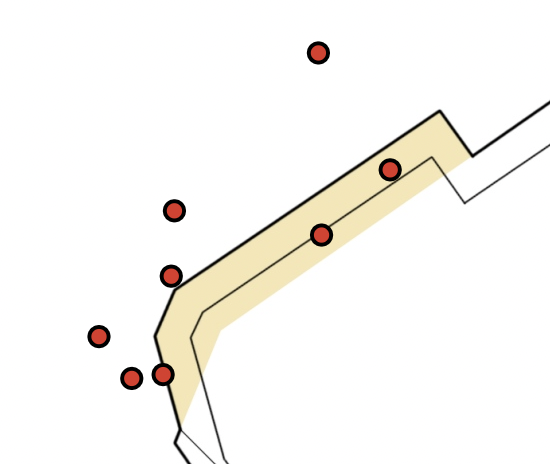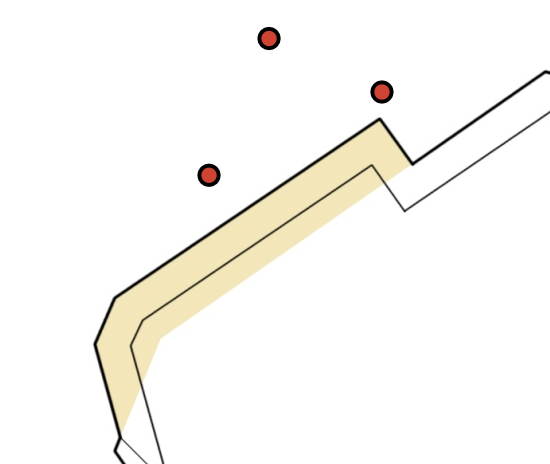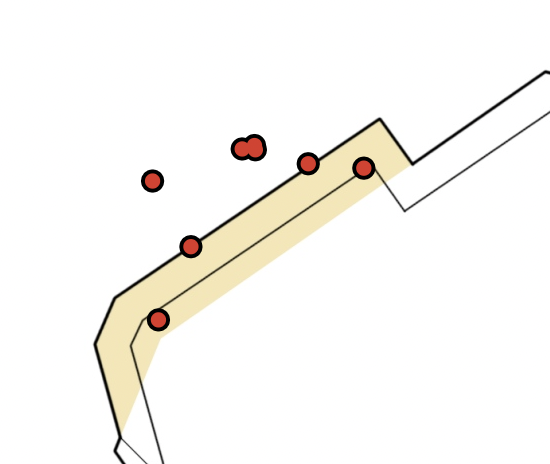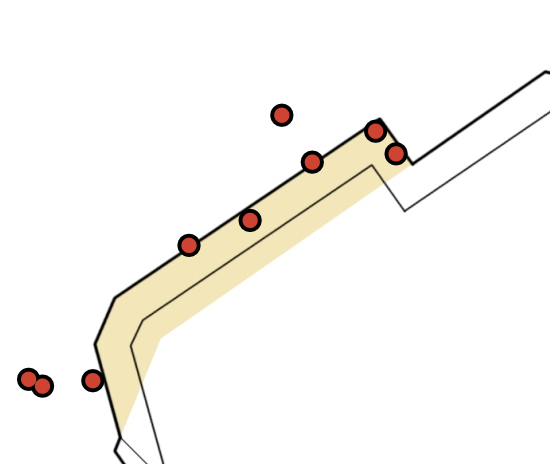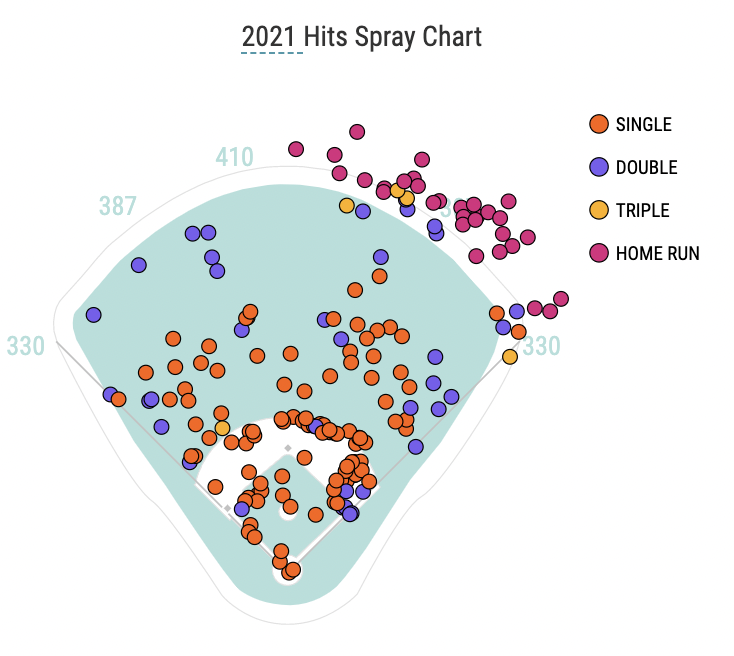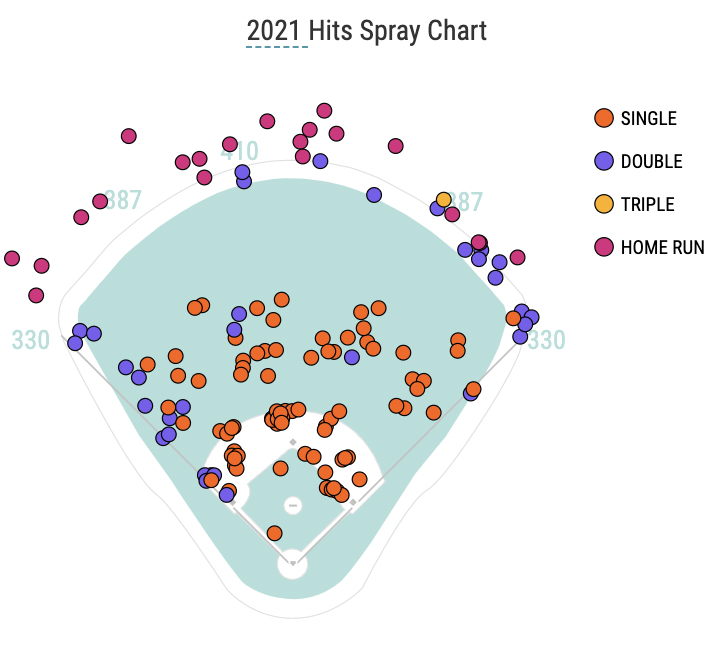[Update 1/15/22 – Since this article was written, the Orioles released renderings of the new wall. With more information on the dimensions, we can make better estimates of the impact on home runs to left field. Andrew Perpetua used the renderings to map home runs from previous years onto the new outfield. Here is the map for Ryan Mountcastle’s 2021 homers:
Mountcastle hit eight HR to this area in 2021 and you can see that two will fall in front of the new wall (the thick black line) while a third and fourth might barely clear the fence. I had assumed he would lose 3-4 HR from the change, and that appears to be roughly true.
On the other hand, Trey Mancini’s HR in this area all appear to clear the wall.
That doesn’t mean Mancini won’t be impacted, but based on his 2021 homers, the impact on him should be smaller.
Austin Hays might be hardest hit.
Four of his eight homers are at risk, and he does not have the deep no-doubters of the other two.
Meanwhile, the hit chart for John Means looks pretty good. He gave up very few long home runs and 5-6 of the ones he gave up to this area might be saved by the new dimensions.
Taken together, I would be a bit more pessimistic on the bats and a bit more optimistic on Means than portrayed in the article below. The exception is Cedric Mullins, whose power is to RF and who therefore should avoid the negative effects of this change.]
While the baseball world waited to hear what kind of discussions MLB and the MLBPA planned to have, the Orioles dropped some big news on the fantasy world.
The club told The Baltimore Sun it began construction this week to alter Oriole Park at Camden Yards’ left-field dimensions to try to reduce the stadium’s propensity for home runs. The changes — the first to the size of the iconic ballpark’s playing area in two decades — will raise the wall’s height from 7 feet to about 12 feet and move it back as much as 30 feet, according to information provided by the team. Major League Baseball approved the adjustments, which will cover the area from the left-field corner to the bullpens in the left-center field.
Those changes are no joke! Raising the wall five feet and moving it back up to 30 feet should have an impact. For fantasy players, the question is how much of an impact and what should we do about it?
Before looking at specific players, it’s worth looking at Oriole Park at Camden Yards (OPACY) as it compares to other ballparks. Per Baseball Savant, OPACY has the 2nd highest park factor for home runs, both overall and for the right-handed hitters whose power will be most impacted by this change.
But the park sits very much middle-of-the-pack for other hits — 16th for singles and 14th for both doubles and triples. This isn’t a huge surprise. Short fences make for easy home runs. They also create smaller, easier-to-defend outfields where fewer balls in-play find grass. The only park with a higher homer factor is Great American Ballpark in Cincinnati with its similarly small outfield, good for 10th for singles and doubles and dead last for triples.
Making the fence taller and moving it back will result in fewer homers since the ball has to travel higher and further to reach the seats, but it will also result in more hits on balls in play. Those extra hits will include some doubles that bang off the new high wall and some line drives and bloops that find grass in front of outfielders forced to cover more ground.
How many fewer home runs will be hit and how many more base hits will fall in? I don’t think it makes a ton of sense to speculate; people far smarter than me will probably do some calculations once we have actual dimensions. Instead, I will look at how this change impacts the fantasy value of six Orioles: Cedric Mullins, Ryan Mountcastle, Trey Mancini, Austin Hays, Anthony Santander, and John Means. Those six, plus Adley Rutschman (more on him later), are the only Orioles with an ADP under 437 at NFBC.
Mullins (NFBC ADP: 28.7) broke out in a big way in 2021, posting a 30/30 season after giving up switch-hitting in favor of hitting full-time from the left side. There have been questions about whether or not Mullins can repeat that type of power output and moving the fences back seems like it might hurt him, but check out this spray chart:
Certainly doesn’t look like moving back the fence in left is going to take any home runs away from Mullins. All of his power was to the pull side. It’s of course possible he would have gone oppo taco at some point in 2022 — and that is now less likely — but there is no real reason to think this will negatively impact his power output.
On the other hand, Mullins had a decent number of hits that landed in left, and the newer, larger dimensions should be friendly to any line drives or bloops he sprays to that part of the park. I could see a small boost to his average and ability to get on base, thanks to this. In general, though, I am not changing my valuation of Mullins at all as a result of this change.
This change may hit a right-handed bat like Mountcastle (NFBC ADP: 108.4) harder. Sure enough, in 2021 Mountcastle pulled nine homers over the leftfield wall in OPACY, more than a quarter of his total for the season. How much he is impacted depends a bit on what, exactly, the changes are. For example, do we think this would still be a home run in 2022?
My best guess is the wall won’t be deeper in the corner than it is today. But that ball doesn’t clear the fence at 7’1″ let alone 12′. However, not being a home run doesn’t mean a bad outcome. That ball was smoked and was likely to turn into a double, though Mountcastle might have lost an RBI along with the homer.
This, on the other hand, cares not for your giant walls nor your deep power alleys.
I went through all nine of Mountcastle’s homers, and I suspect all but two would still be HR, with one of those two turning into a double, and the other into an out.
However, Mountcastle also has an all-fields, line-drive-heavy approach that would benefit from a bit more space in the outfield. A deeper alley in leftfield likely means more hits, more doubles, and more opportunities for guys on base in front of him to come around and score even when the ball doesn’t clear the fence.
I am going to be a bit conservative with my expectations and assume this costs him more like three or four home runs instead of the two I mentioned above. But I also think it helps his average a bit. Losing those homers hurts his value, but I am not dropping him multiple rounds or anything like that; I would still take him around the same place I would have yesterday, with maybe a couple of bats moved ahead of him.
While Mountcastle has OF eligibility, Mancini (NFBC ADP: 185.2) is 1B-only. And while Mountcastle hit 33 home runs last year, Mancini had only 21. On the other hand, Mancini only pulled three home runs to LF at home in 2021. Mancini’s power tends to be more up the middle.
He did the same in this 35-homer 2019 season, hitting homers to all fields including a lot back up the middle. Those three pulled homers at home, by the way, traveled 408, 414, and 455 feet. The new dimensions will be deeper, but those three were all getting out anyway.
That said, I can’t just brush off a significant change to his pull side because he hit three majestic shots in 2021. Looking at his spray chart, he hit about half his homers to left or left-center last year. Fantasy managers buying Mancini are looking for more power from him in 2022 and at least some of that power needed to come from taking more advantage of those LF seats.
I would, as with Mountcastle, lower my expectations on Mancini by a bit for 2022. Conveniently for me, I think he is being undervalued in drafts, and so I am still very happy to take him at his current ADP. This is a case where if other managers are overreacting and letting him fall closer to 200, you can take him and profit.
Hays (NFBC ADP: 207.5) is a different story. Hays had 22 homers, 8 pulled, at OPACY. More than a third of his power on the year was reliant on that fence. Like Mancini and Mountcastle, he hit some bombs that aren’t going to be held back by any fence, but watching his eight home runs, I thought at least three could be questionable with the new dimensions. That’s a pretty sizable chunk of his power that is put in danger. If I make the same conservative assumption for him I did with the other two — that my estimate of how many of his 2021 homers would fall short is a little low — we could be talking about him losing more like five home runs.
But, before we write him off, there is a way that this change plays to his benefit. Hays appears likely to be the everyday left fielder for the Orioles. His main competition for playing time out there — DJ Stewart either playing LF or moving Mountcastle to LF while Stewart DHs — are really bad fielders, while Hays is a very good fielder. And this change is going to make LF defense a lot more important for the Orioles. Even if the Orioles have other bats they want to get into their lineup, it’ll be harder than ever to put Hays and his glove on the bench.
Steamer projects Hays for 26 homers as of now, and I think we need to assume the new dimensions could mean he hits more like 20-22, instead. But I also think his playing time is more secure. I’ll be moving him down my boards a bit, but again, not overreacting.
The one switch-hitter of the group, Santander (NFBC ADP: 247.5) hit five home runs over that fence in 2021. He pulled four from the right side and one came from the left side. Of those five, two looked questionable, though they might have both still made it out. It’s hard to know for sure without knowing the actual plans for the new fence.
One challenge with Santander is he doesn’t provide high value in multiple categories. He projects for 26 homers, but with an average in the .240s and no speed to speak of, that isn’t doing a ton for you. If the new fence pushes him below 25, let alone closer to 20 bombs in 2022, his value dries up quickly. Going just inside the 250th pick, he is mostly a late-round flyer anyway, but this might be enough to push me out on him.
It’s not that I think he’ll be impacted more than the other guys. However, there are plenty of interesting late picks and I don’t feel the need to draft the guy who has to contend with these changes.
Another Pitcher List writer, who happens to be an Orioles fan, already did the heavy-lifting on Means (NFBC ADP: 223.9):
John Means allowed 15 HR at Camden Yards this year.
While 9 were to left field, just 1 of those 9 would have stayed in the yard with the new dimensions.
Still think this will end up being a really good thing for the staff though.
— Alex Fast (@AlexFast8) January 12, 2022
I mean, let’s be honest, you would rather hear from Alex on this than from me, right? I know I would!
Alex looked at each of Means’ home runs allowed to left and determined the new dimensions would only keep one in the park. Means gives up a lot of hard contact, so a decent chunk of his HR-allowed well over the fence. The new dimensions will help him, perhaps taking more than one HR off the board, but he’s still not in a pitcher’s park.
Per Steamer, Means projects for a 4.48 ERA, which is pretty much in line with his 2021 peripherals. If I had to put a stake in the ground as to how much this will lower my projection for his ERA, I would say from 4.48 to maybe 4.40. He might save himself a home run, cost himself a couple more hits on balls in play, and in the end be basically what we already expect.
I have been relatively low on Means. There are multiple pitchers taken after him that I like better. His ADP is immediately followed by Jordan Montgomery and Patrick Sandoval. Huascar Ynoa and Triston McKenzie are the next two SP after that. I would prefer any of those four. So take this with a grain of salt if you are a Means fan. This moves him from a guy I wasn’t drafting to a guy I am still not drafting. I suspect we’ll see a burst of interest in Means as an upside play thanks to the new LF fence, but I won’t be participating.
The Prospects
I said earlier that we would get to Adley Rutschman and here we are. Given we don’t have video of Rutschman hitting at Camden Yards, it’s hard to break down how this would impact him. From what we saw on the other bats, I am not changing my outlook on him over this. Rutschman has plenty of power to carry over the old fence, the new fence or really just about any fence. Plus, he is a switch-hitter who should bat left-handed most of the time.
As for Grayson Rodriguez and DL Hall, the new dimensions can only help them. Not overreacting is boring, but I am still not overreacting. I don’t think OPACY is going to be a power desert and I don’t think Hall and Rodriguez see huge benefits. But if you want to move them both up the SP prospect rankings a nudge, I won’t argue.
The Road Teams
In 2021, Aaron Judge hit four bombs to left field at Oriole Park. Lourdes Gurriel, Jr., hit three. Those were your MLB leaders in “HR to left at Oriole Park by a road player.”
Even for guys like Judge and Gurriel in the AL East, they only play up to 10 games in Baltimore. Will some road players lose to the new fence? That seems to be the entire point of the change, so the Orioles better hope so! But we can’t reasonably project any individual road player will see their season-long production impacted.
Photo by Mark Goldman/Icon Sportswire | Adapted by Ethan Kaplan (@DJFreddie10 on Twitter and @EthanMKaplanImages on Instagram)

